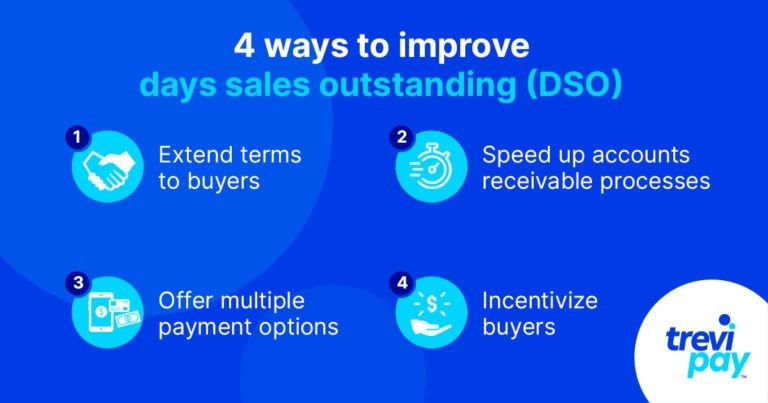Effective cash flow management gives you more control of your business, its financial performance and overall health.
It allows you to pay off debts and make reinvestments, as well as prepare for economic uncertainty or hardships.
Minimizing your days sales outstanding (DSO) is an essential part of improving your cash flow and cash management, too.
Let’s look at how you can do this.
What is days sales outstanding (DSO)?
The term days sales outstanding (DSO) (sometimes referred to as days receivables or cash collection period) describes a measure of the number of days it takes accounts receivable to collect cash from outstanding invoices.
It is part of the cash conversion cycle and is usually determined on a monthly, quarterly, or annual basis.
DSO doesn’t measure against just one customer. Instead, it takes the measure of all outstanding invoices.
Is a high DSO good?
A high DSO, especially one that is still getting higher, is not a good sign. It shows that your company is taking a long time to collect its receivables – and your process is not improving.
You can’t use cash that is tied up in your receivables. When working capital decreases quicker than healthy cash flow comes in, a cash flow crunch can occur.
Is a low DSO always good?
Whilst a low DSO is generally a good thing, one that’s too low (i.e., well below your industry’s average) might mean your collection policy is too stringent.
In fact, you might be unknowingly discouraging customers because of your credit policy.
What is a “good” DSO?

The answer to ‘what is a good DSO?’ depends on two main factors.
1. The industry affects DSO
For some industries, a high DSO is a part of doing business in that industry. Broadly speaking, high DSOs range from 66 to 125 days.
For example, a 2024 report from Dun & Bradstreet reported that the industries with the highest DSO are Oil and gas extraction and construction.
2. The time period in question
Industry DSO averages can change each year and within different points of the same year, too.
Consider whether your company’s current DSO status suits your company or your customers most. If your industry’s average DSO is 45 days, but your company’s is 60 days, can you justify this 15-day difference?
Giving customers longer to pay can increase sales. But if it is causing your business cash flow problems and late paying suppliers as a result, it’s time to rethink the net terms you offer.
The importance of monitoring DSO metrics
Monitoring the DSO of your business is essential.
Of course, fluctuation happens. But knowing where your DSO stands at any given time, and payment terms relative to your industry, gives you valuable insights into your cash flow.
So, you should do a benchmarking analysis of your industry. And you should make it a strategic priority to incorporate DSO improvement metrics into your reporting process.
B2B should be more like B2C
B2B buyers increasingly want the same frictionless buyer journey and payment experience they’ve come to expect in the B2C world.
After all, B2B buyers are also B2C buyers in their free time…
And just like B2C companies, B2B companies want to easily manage cash flow while offering customers great online shopping experiences.
But unlike B2C customers, B2B buyers rarely expect to make upfront payments. This makes improving DSO – and credit management more generally – a unique challenge for B2B suppliers.
What could be causing a DSO rise?
If you see your DSO rapidly increasing, it could be a warning sign that something is wrong — or about to go wrong.
Your company’s cash flow could be at risk. If you can’t reinvest in your business or make prompt payments to suppliers, your operations can be seriously disrupted.
But before you can improve DSO (i.e., reduce DSO), you need to diagnose the problem.
Here are a few possible causes.
1. Customer satisfaction
A decline in customer satisfaction might be caused by a range of reasons, including:
- Pricing rises
- Quality decline
- Poor relationships
- Bad collections protocol
- Slow response times
- Inefficient accounting processes (such as slow invoice processing)
Figuring out and fixing this problem is essential.
2. Customer credit risk
Your sales representatives might try to hit their sales goals by offering longer payment terms to customers as part of the deal. Perhaps even for customers that traditionally paid in shorter periods.
Or perhaps you are allowing customers with subpar credit histories to make purchases on credit.
3. Outside economic factors
Industries change and so does the wider economy. Changes in one or both of these will often have a significant impact on your business.
8 ways to improve DSO

Thankfully, there are a few steps you can take toward improving your DSO.
These will ultimately ensure your customers are paying on time and increase your company’s cash flow.
1. Extend terms to buyers
If you offer attractive customer incentives, there’s a good chance many will respond. A whopping 82% of B2B buyers would choose a vendor over others if that vendor offered invoicing at checkout with 30-, 60- or 90-day terms, and 74% of B2B buyers were presented with the option of paying by invoice to buy more products or services.
One of the main ways to do this is to offer B2B credit onboarding. You can eliminate the source of high DSO (the payment itself) by implementing invoicing technology that also extends credit to buyers on your behalf.
By enabling certain customers to access credit, you can increase their ability to increase their own revenue and – ultimately – pay you. It can effectively put an end to the need for reminding customers of due dates and late payments.
2. Speed up accounts/receivable processes
By outsourcing A/R processes, your team can handle an influx of new business without sacrificing efficiency. Third-party providers can help with many aspects of this, including:
- Underwriting
- Onboarding
- Invoice submission
- Matching remittance information
- Reconciliation
- Collections
3. Incentivize buyers
Motivate buyers to settle invoices early by offering discounts and communicating the potential for late fees on past due payments. For example, if a buyer is paying on net terms, reward early payments by giving a discount to those who pay within a week or 10 days. Whether it’s discounting the current purchase or offering to take 10% off the next one, rewarding buyers who are on top of their invoices incentivizes them to pay on time and earns their appreciation and loyalty in the long run.
4. Offer multiple payment options
Customers want to pay using their preferred payment method. If that’s not available, they may be slow to pay — or worse, they may abandon the transaction together.
By offering multiple payment options, you’re more likely to allow them to pay how they like and receive their payment on time or sooner.
A purchasing experience that’s in line with their increasing expectations may also boost loyalty and repeat purchases. 98% of B2B buyers believe it’s important to have the same purchasing experiences across all channels, which includes in-store, sales, online and by phone.
Increasingly, offering online alternative payment methods that offer speed, convenience and personalization, such as net terms, is necessary.
5. Offer order-to-cash
One way to drive down DSO is through understanding and improving your order-to-cash process. This is the process of managing the flow of orders and payments from customers.
This involves several activities.
Streamlining the order process
This can involve simplifying the process for customers to place orders and making it easier for them to understand the payment terms.
Improving billing accuracy
Ensuring that bills are accurate and sent to the correct person can help reduce the time it takes to collect payment.
Offering flexible payment options
Providing customers with a range of payment options can make it easier for them to pay on time. Examples of payment capabilities include paying online, with different currencies, check or via standing orders.
6. Improve dunning process
Dunning is the process (or processes) for following up on unpaid invoices. Regular dunning or working with customers to resolve any issues around unpaid invoices can speed up the collection and billing process.
Dunning can take place via multiple communication channels. It should be done regularly, with several communications issued to each customer.
Unfortunately, reminding your customers of penalties as well as deadlines is essential. But you can also offer to waive late fees as an incentive in certain circumstances and avoid the need for debt collection.
7. Account Receivable Automation
You can improve DSO by automating your accounts receivable.
Automation removes much of the human intervention and errors that go along with it. The end result is likely to be a great improvement in efficiency and cost reduction.
You can automate everything from your invoicing processes to automated payment reminders.
8. Outsource collections
Sending invoices to collection agencies can increase your DSO further. Some customers will pay collection agencies quicker.
This might be because of the efficiency of collection agencies’ processes or the client’s worry about the consequences of paying them late. Unlike with most businesses, paying collection agencies late can negatively impact credit insurance ratings and credit scores.
Improve DSO with industry-standard best practices
TreviPay can help automate your B2B company’s accounts receivable which can decrease DSO and increase cash flow.
With our accounts receivable management tools, you can easily automate your days sales and outstanding balances by extending risk-free credit to your customers, while ensuring you always get paid within days.
Implementing TreviPay enables you to provide multiple payment options and lower DSO — ultimately removing the challenges accompanying restricted cash flow.






